Analysis of Business Types, Organizational Structures and HSBC Report
VerifiedAdded on 2020/01/07
|8
|1619
|287
Report
AI Summary
This report provides a comprehensive analysis of different business types and organizational structures, focusing on their implications for HSBC. It examines sole traders, partnerships, private companies, public companies, and voluntary organizations, outlining their respective advantages and disadvantages. The report also explores hierarchical and matrix organizational structures, discussing their strengths, weaknesses, and impact on decision-making, communication, and overall organizational goals. The analysis considers how these factors influence HSBC's interactions with various clients and its approach to financing and risk management. The report draws on academic sources to support its arguments and provide a well-rounded perspective on the subject matter.

Running head: BUSINESS AND BUSINESS ENVIRONMENT
Business and Business Environment
Name
Institution
Business and Business Environment
Name
Institution
Paraphrase This Document
Need a fresh take? Get an instant paraphrase of this document with our AI Paraphraser
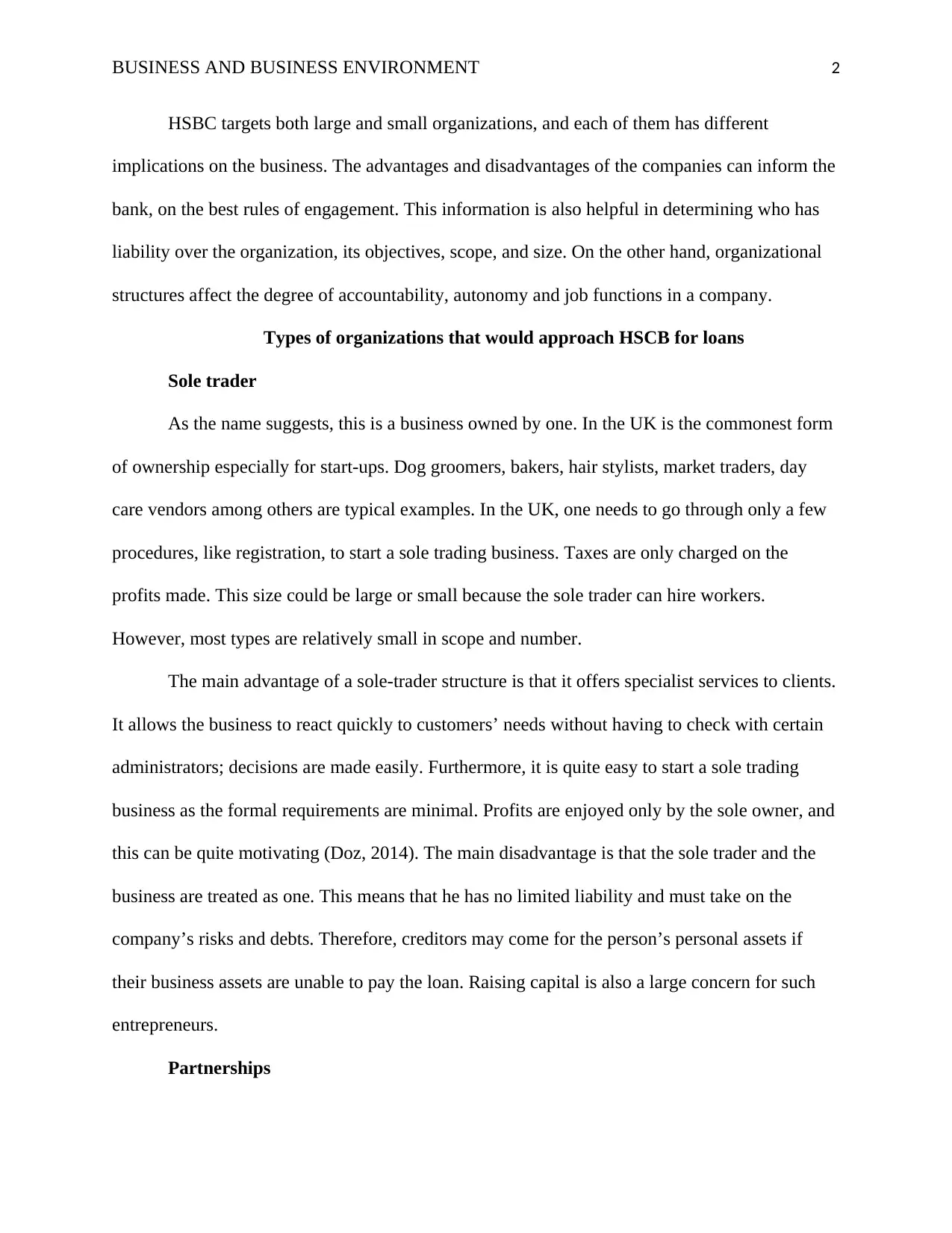
BUSINESS AND BUSINESS ENVIRONMENT 2
HSBC targets both large and small organizations, and each of them has different
implications on the business. The advantages and disadvantages of the companies can inform the
bank, on the best rules of engagement. This information is also helpful in determining who has
liability over the organization, its objectives, scope, and size. On the other hand, organizational
structures affect the degree of accountability, autonomy and job functions in a company.
Types of organizations that would approach HSCB for loans
Sole trader
As the name suggests, this is a business owned by one. In the UK is the commonest form
of ownership especially for start-ups. Dog groomers, bakers, hair stylists, market traders, day
care vendors among others are typical examples. In the UK, one needs to go through only a few
procedures, like registration, to start a sole trading business. Taxes are only charged on the
profits made. This size could be large or small because the sole trader can hire workers.
However, most types are relatively small in scope and number.
The main advantage of a sole-trader structure is that it offers specialist services to clients.
It allows the business to react quickly to customers’ needs without having to check with certain
administrators; decisions are made easily. Furthermore, it is quite easy to start a sole trading
business as the formal requirements are minimal. Profits are enjoyed only by the sole owner, and
this can be quite motivating (Doz, 2014). The main disadvantage is that the sole trader and the
business are treated as one. This means that he has no limited liability and must take on the
company’s risks and debts. Therefore, creditors may come for the person’s personal assets if
their business assets are unable to pay the loan. Raising capital is also a large concern for such
entrepreneurs.
Partnerships
HSBC targets both large and small organizations, and each of them has different
implications on the business. The advantages and disadvantages of the companies can inform the
bank, on the best rules of engagement. This information is also helpful in determining who has
liability over the organization, its objectives, scope, and size. On the other hand, organizational
structures affect the degree of accountability, autonomy and job functions in a company.
Types of organizations that would approach HSCB for loans
Sole trader
As the name suggests, this is a business owned by one. In the UK is the commonest form
of ownership especially for start-ups. Dog groomers, bakers, hair stylists, market traders, day
care vendors among others are typical examples. In the UK, one needs to go through only a few
procedures, like registration, to start a sole trading business. Taxes are only charged on the
profits made. This size could be large or small because the sole trader can hire workers.
However, most types are relatively small in scope and number.
The main advantage of a sole-trader structure is that it offers specialist services to clients.
It allows the business to react quickly to customers’ needs without having to check with certain
administrators; decisions are made easily. Furthermore, it is quite easy to start a sole trading
business as the formal requirements are minimal. Profits are enjoyed only by the sole owner, and
this can be quite motivating (Doz, 2014). The main disadvantage is that the sole trader and the
business are treated as one. This means that he has no limited liability and must take on the
company’s risks and debts. Therefore, creditors may come for the person’s personal assets if
their business assets are unable to pay the loan. Raising capital is also a large concern for such
entrepreneurs.
Partnerships

BUSINESS AND BUSINESS ENVIRONMENT 3
They involve two to 20 people who either bring resources or money to business.
Sometimes ideas and skills are a reason to form partnerships. In the UK, a partnership deed
specifying details of the firm, such as when capital will be provided, profit and loss sharing,
terminating the relationship, and voting, is required. Most partnerships are relatively larger than
sole trading businesses. Typical examples include service practitioners, dentist and medical
professionals doing private practice, law firms, and individual retail organizations. It is not a
separate legal entity (they still have unlimited liability) but is a separate accounting entity where
taxes paid on profits.
The main advantage of this structure is it spreads risks to several people so when in debt,
it is easier to handle it. More partners infuse more resources, skills, ideas, and finance into the
business. They seem credible to suppliers and customers as they are less risky. On the flipside,
partnerships may cause disputes over workload and profit sharing. Some may disagree over
control of the business, and there may challenge with the direction of the firm. It is an
arrangement with limited life and still has unlimited liability.
Private
It refers to an organization that is owned by shareholders and directors are appointed to
run it; it also possesses limited liability. Typical examples include some insurance firms and
lending institutions. In most instances, the directors happen to be shareholders, but if not, they
must act in the shareholders’ best interest. Performance and decisions ought to be accounted. To
set up a private company, one needs a certificate of incorporation for registration, articles of
association for internal rules and a memorandum of association for the enterprise objectives.
The main advantage of a private company is its limited liability which implies that
investors only lose the money they put in. It encourages many investors to finance the company.
They involve two to 20 people who either bring resources or money to business.
Sometimes ideas and skills are a reason to form partnerships. In the UK, a partnership deed
specifying details of the firm, such as when capital will be provided, profit and loss sharing,
terminating the relationship, and voting, is required. Most partnerships are relatively larger than
sole trading businesses. Typical examples include service practitioners, dentist and medical
professionals doing private practice, law firms, and individual retail organizations. It is not a
separate legal entity (they still have unlimited liability) but is a separate accounting entity where
taxes paid on profits.
The main advantage of this structure is it spreads risks to several people so when in debt,
it is easier to handle it. More partners infuse more resources, skills, ideas, and finance into the
business. They seem credible to suppliers and customers as they are less risky. On the flipside,
partnerships may cause disputes over workload and profit sharing. Some may disagree over
control of the business, and there may challenge with the direction of the firm. It is an
arrangement with limited life and still has unlimited liability.
Private
It refers to an organization that is owned by shareholders and directors are appointed to
run it; it also possesses limited liability. Typical examples include some insurance firms and
lending institutions. In most instances, the directors happen to be shareholders, but if not, they
must act in the shareholders’ best interest. Performance and decisions ought to be accounted. To
set up a private company, one needs a certificate of incorporation for registration, articles of
association for internal rules and a memorandum of association for the enterprise objectives.
The main advantage of a private company is its limited liability which implies that
investors only lose the money they put in. It encourages many investors to finance the company.
⊘ This is a preview!⊘
Do you want full access?
Subscribe today to unlock all pages.

Trusted by 1+ million students worldwide
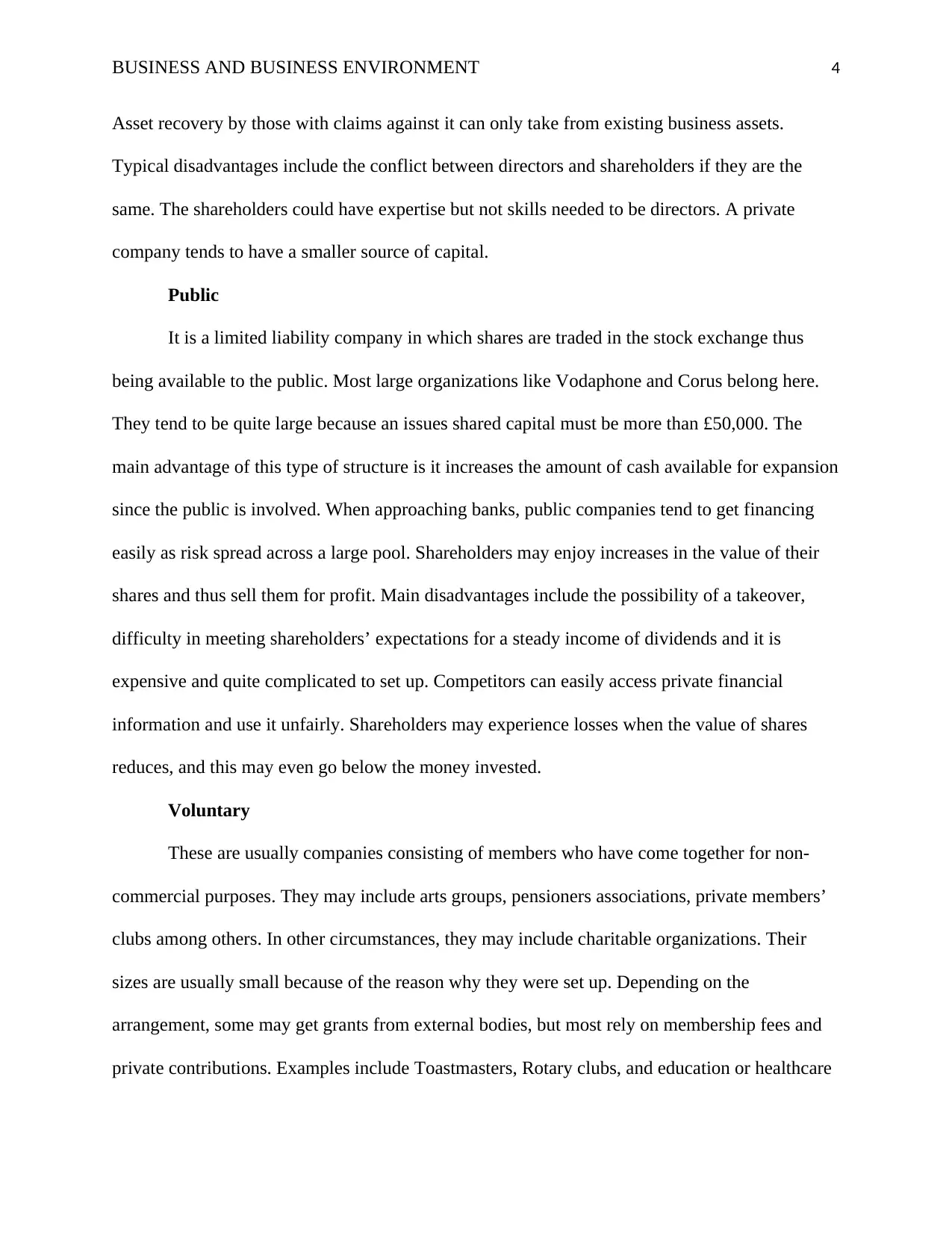
BUSINESS AND BUSINESS ENVIRONMENT 4
Asset recovery by those with claims against it can only take from existing business assets.
Typical disadvantages include the conflict between directors and shareholders if they are the
same. The shareholders could have expertise but not skills needed to be directors. A private
company tends to have a smaller source of capital.
Public
It is a limited liability company in which shares are traded in the stock exchange thus
being available to the public. Most large organizations like Vodaphone and Corus belong here.
They tend to be quite large because an issues shared capital must be more than £50,000. The
main advantage of this type of structure is it increases the amount of cash available for expansion
since the public is involved. When approaching banks, public companies tend to get financing
easily as risk spread across a large pool. Shareholders may enjoy increases in the value of their
shares and thus sell them for profit. Main disadvantages include the possibility of a takeover,
difficulty in meeting shareholders’ expectations for a steady income of dividends and it is
expensive and quite complicated to set up. Competitors can easily access private financial
information and use it unfairly. Shareholders may experience losses when the value of shares
reduces, and this may even go below the money invested.
Voluntary
These are usually companies consisting of members who have come together for non-
commercial purposes. They may include arts groups, pensioners associations, private members’
clubs among others. In other circumstances, they may include charitable organizations. Their
sizes are usually small because of the reason why they were set up. Depending on the
arrangement, some may get grants from external bodies, but most rely on membership fees and
private contributions. Examples include Toastmasters, Rotary clubs, and education or healthcare
Asset recovery by those with claims against it can only take from existing business assets.
Typical disadvantages include the conflict between directors and shareholders if they are the
same. The shareholders could have expertise but not skills needed to be directors. A private
company tends to have a smaller source of capital.
Public
It is a limited liability company in which shares are traded in the stock exchange thus
being available to the public. Most large organizations like Vodaphone and Corus belong here.
They tend to be quite large because an issues shared capital must be more than £50,000. The
main advantage of this type of structure is it increases the amount of cash available for expansion
since the public is involved. When approaching banks, public companies tend to get financing
easily as risk spread across a large pool. Shareholders may enjoy increases in the value of their
shares and thus sell them for profit. Main disadvantages include the possibility of a takeover,
difficulty in meeting shareholders’ expectations for a steady income of dividends and it is
expensive and quite complicated to set up. Competitors can easily access private financial
information and use it unfairly. Shareholders may experience losses when the value of shares
reduces, and this may even go below the money invested.
Voluntary
These are usually companies consisting of members who have come together for non-
commercial purposes. They may include arts groups, pensioners associations, private members’
clubs among others. In other circumstances, they may include charitable organizations. Their
sizes are usually small because of the reason why they were set up. Depending on the
arrangement, some may get grants from external bodies, but most rely on membership fees and
private contributions. Examples include Toastmasters, Rotary clubs, and education or healthcare
Paraphrase This Document
Need a fresh take? Get an instant paraphrase of this document with our AI Paraphraser
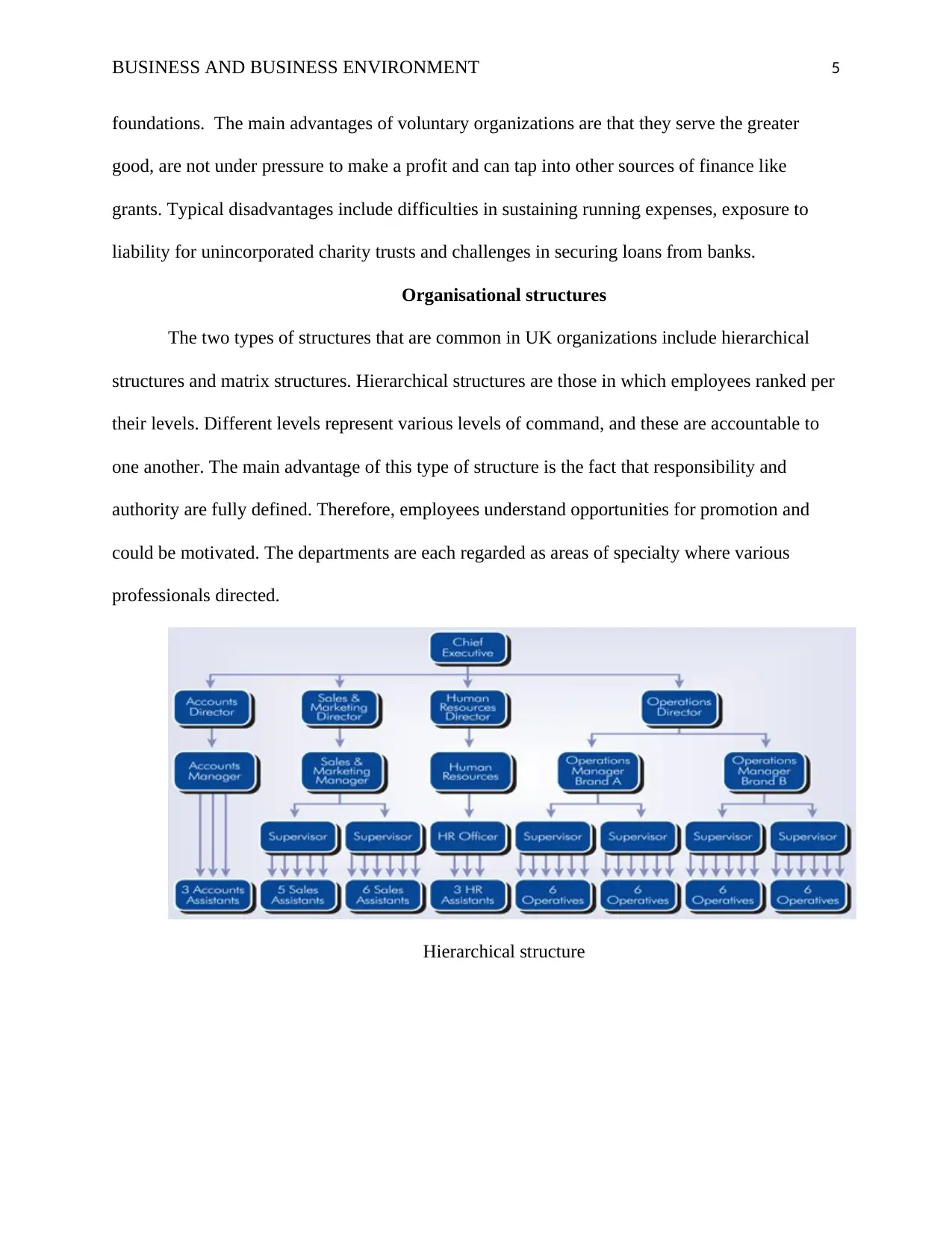
BUSINESS AND BUSINESS ENVIRONMENT 5
foundations. The main advantages of voluntary organizations are that they serve the greater
good, are not under pressure to make a profit and can tap into other sources of finance like
grants. Typical disadvantages include difficulties in sustaining running expenses, exposure to
liability for unincorporated charity trusts and challenges in securing loans from banks.
Organisational structures
The two types of structures that are common in UK organizations include hierarchical
structures and matrix structures. Hierarchical structures are those in which employees ranked per
their levels. Different levels represent various levels of command, and these are accountable to
one another. The main advantage of this type of structure is the fact that responsibility and
authority are fully defined. Therefore, employees understand opportunities for promotion and
could be motivated. The departments are each regarded as areas of specialty where various
professionals directed.
Hierarchical structure
foundations. The main advantages of voluntary organizations are that they serve the greater
good, are not under pressure to make a profit and can tap into other sources of finance like
grants. Typical disadvantages include difficulties in sustaining running expenses, exposure to
liability for unincorporated charity trusts and challenges in securing loans from banks.
Organisational structures
The two types of structures that are common in UK organizations include hierarchical
structures and matrix structures. Hierarchical structures are those in which employees ranked per
their levels. Different levels represent various levels of command, and these are accountable to
one another. The main advantage of this type of structure is the fact that responsibility and
authority are fully defined. Therefore, employees understand opportunities for promotion and
could be motivated. The departments are each regarded as areas of specialty where various
professionals directed.
Hierarchical structure
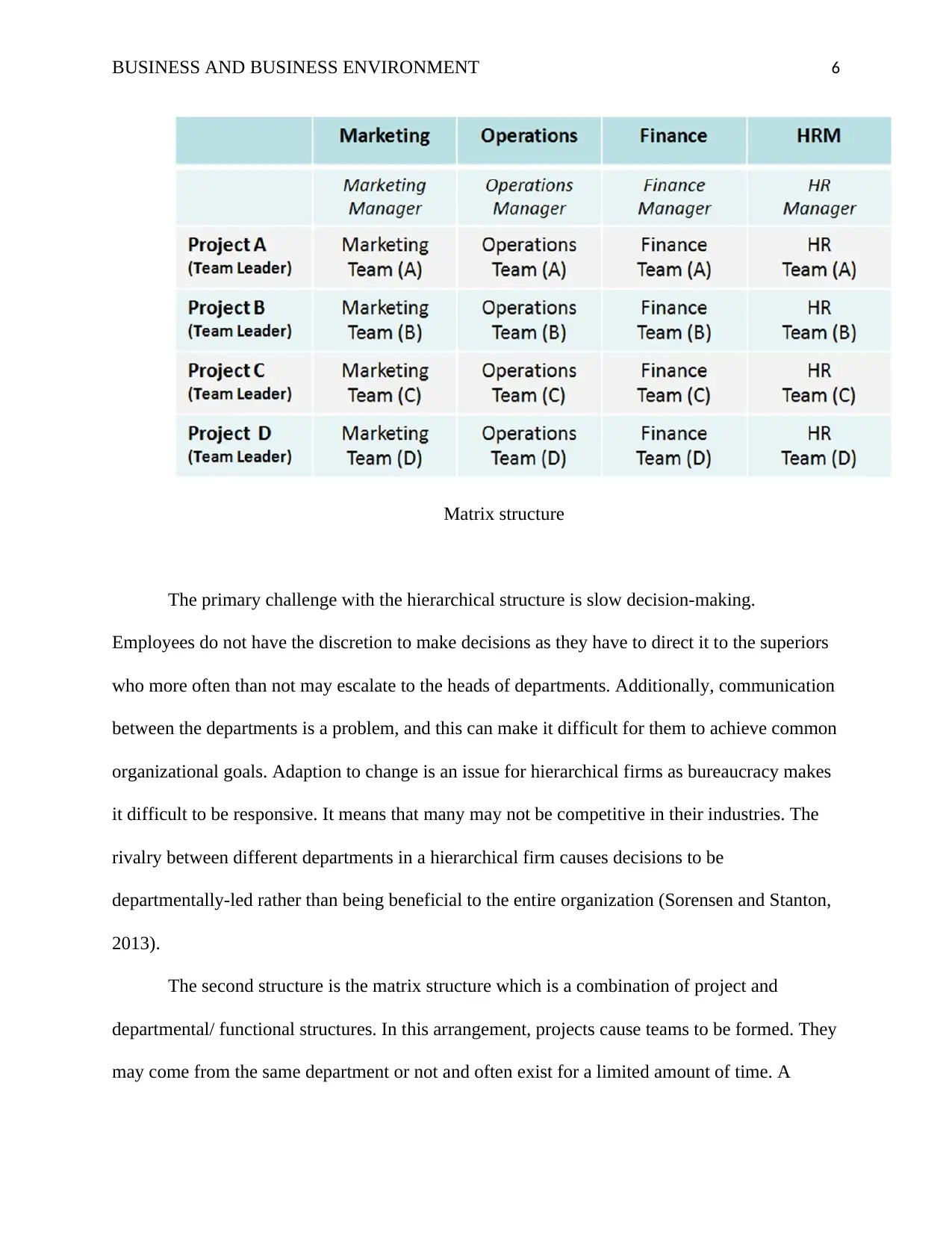
BUSINESS AND BUSINESS ENVIRONMENT 6
Matrix structure
The primary challenge with the hierarchical structure is slow decision-making.
Employees do not have the discretion to make decisions as they have to direct it to the superiors
who more often than not may escalate to the heads of departments. Additionally, communication
between the departments is a problem, and this can make it difficult for them to achieve common
organizational goals. Adaption to change is an issue for hierarchical firms as bureaucracy makes
it difficult to be responsive. It means that many may not be competitive in their industries. The
rivalry between different departments in a hierarchical firm causes decisions to be
departmentally-led rather than being beneficial to the entire organization (Sorensen and Stanton,
2013).
The second structure is the matrix structure which is a combination of project and
departmental/ functional structures. In this arrangement, projects cause teams to be formed. They
may come from the same department or not and often exist for a limited amount of time. A
Matrix structure
The primary challenge with the hierarchical structure is slow decision-making.
Employees do not have the discretion to make decisions as they have to direct it to the superiors
who more often than not may escalate to the heads of departments. Additionally, communication
between the departments is a problem, and this can make it difficult for them to achieve common
organizational goals. Adaption to change is an issue for hierarchical firms as bureaucracy makes
it difficult to be responsive. It means that many may not be competitive in their industries. The
rivalry between different departments in a hierarchical firm causes decisions to be
departmentally-led rather than being beneficial to the entire organization (Sorensen and Stanton,
2013).
The second structure is the matrix structure which is a combination of project and
departmental/ functional structures. In this arrangement, projects cause teams to be formed. They
may come from the same department or not and often exist for a limited amount of time. A
⊘ This is a preview!⊘
Do you want full access?
Subscribe today to unlock all pages.

Trusted by 1+ million students worldwide
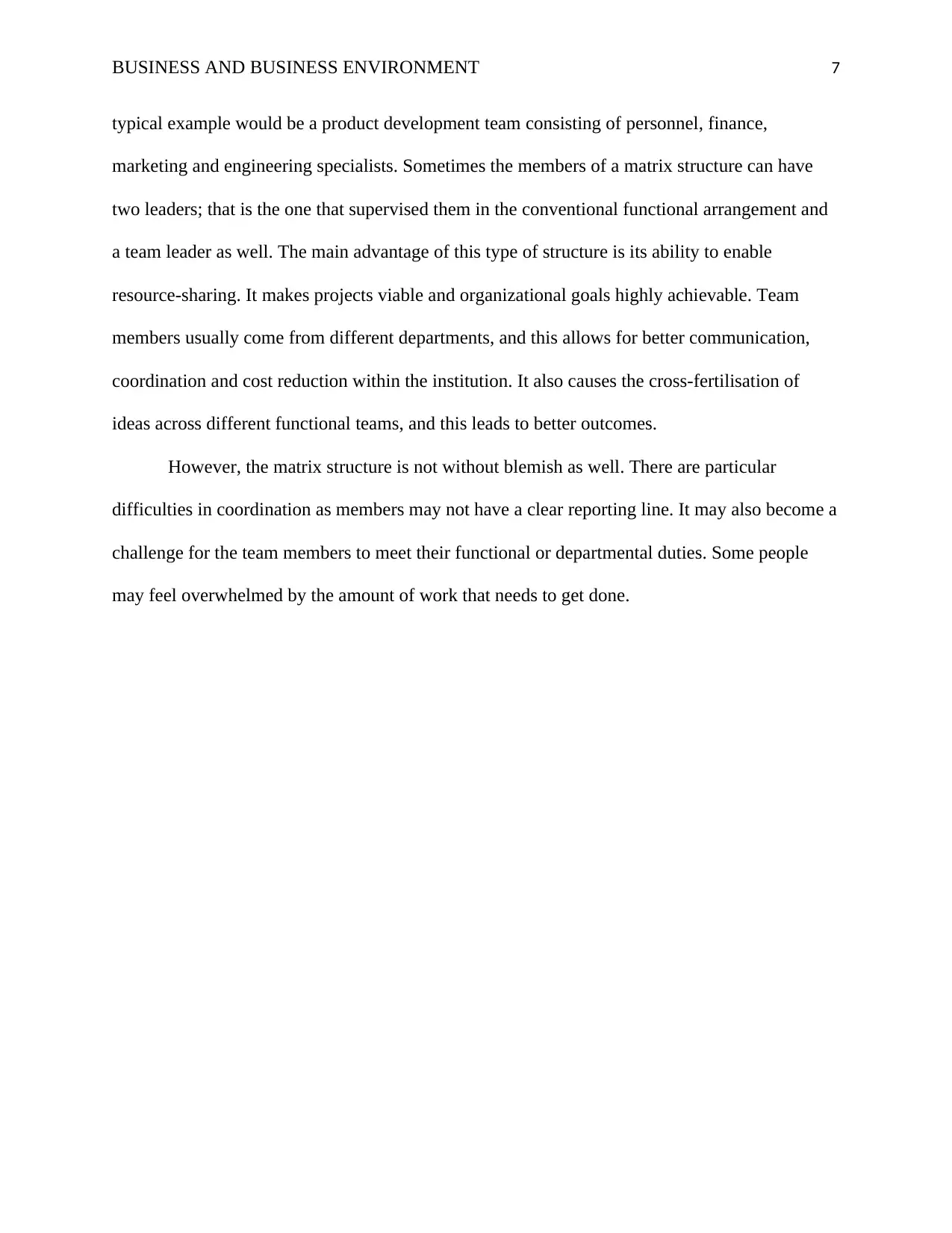
BUSINESS AND BUSINESS ENVIRONMENT 7
typical example would be a product development team consisting of personnel, finance,
marketing and engineering specialists. Sometimes the members of a matrix structure can have
two leaders; that is the one that supervised them in the conventional functional arrangement and
a team leader as well. The main advantage of this type of structure is its ability to enable
resource-sharing. It makes projects viable and organizational goals highly achievable. Team
members usually come from different departments, and this allows for better communication,
coordination and cost reduction within the institution. It also causes the cross-fertilisation of
ideas across different functional teams, and this leads to better outcomes.
However, the matrix structure is not without blemish as well. There are particular
difficulties in coordination as members may not have a clear reporting line. It may also become a
challenge for the team members to meet their functional or departmental duties. Some people
may feel overwhelmed by the amount of work that needs to get done.
typical example would be a product development team consisting of personnel, finance,
marketing and engineering specialists. Sometimes the members of a matrix structure can have
two leaders; that is the one that supervised them in the conventional functional arrangement and
a team leader as well. The main advantage of this type of structure is its ability to enable
resource-sharing. It makes projects viable and organizational goals highly achievable. Team
members usually come from different departments, and this allows for better communication,
coordination and cost reduction within the institution. It also causes the cross-fertilisation of
ideas across different functional teams, and this leads to better outcomes.
However, the matrix structure is not without blemish as well. There are particular
difficulties in coordination as members may not have a clear reporting line. It may also become a
challenge for the team members to meet their functional or departmental duties. Some people
may feel overwhelmed by the amount of work that needs to get done.
Paraphrase This Document
Need a fresh take? Get an instant paraphrase of this document with our AI Paraphraser
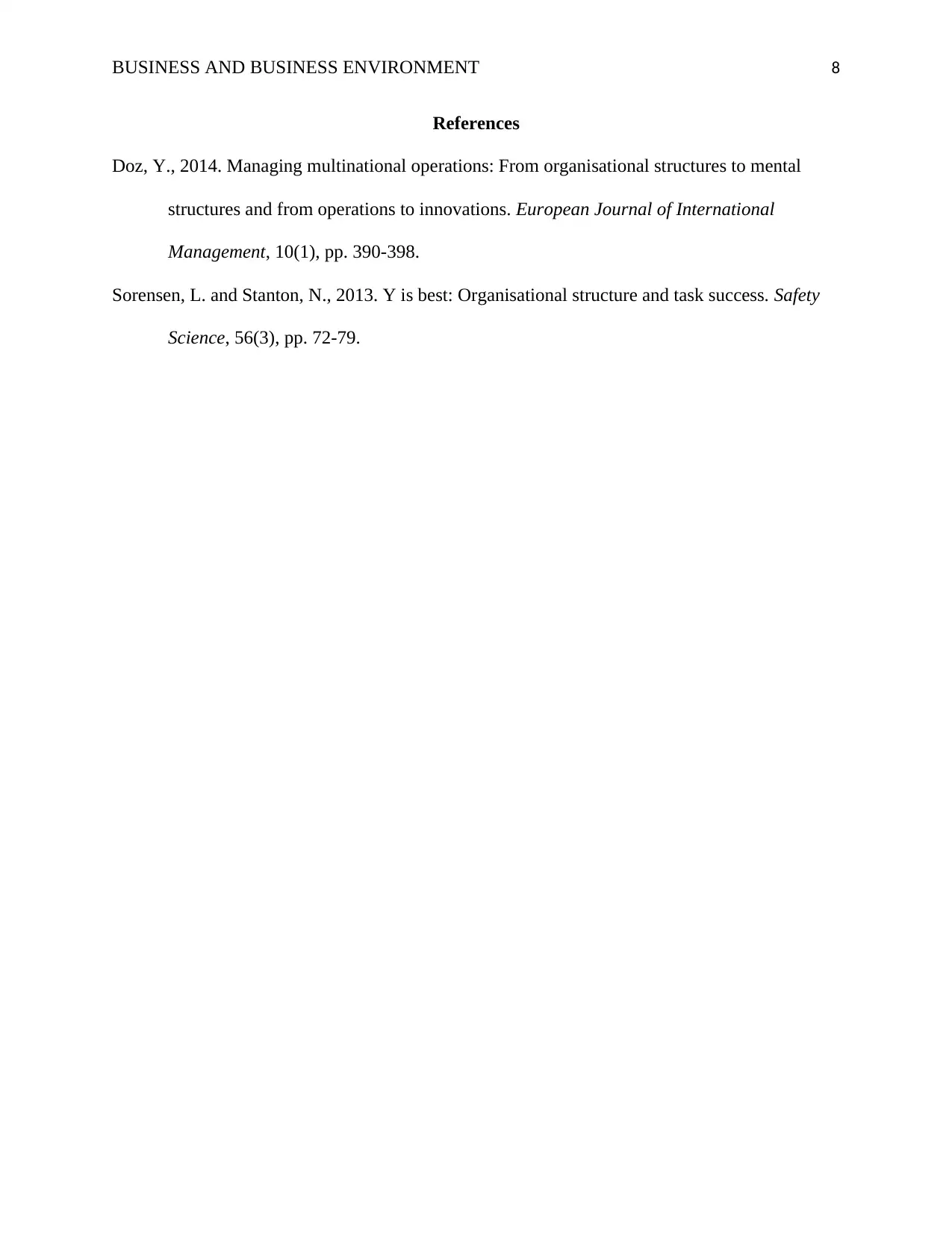
BUSINESS AND BUSINESS ENVIRONMENT 8
References
Doz, Y., 2014. Managing multinational operations: From organisational structures to mental
structures and from operations to innovations. European Journal of International
Management, 10(1), pp. 390-398.
Sorensen, L. and Stanton, N., 2013. Y is best: Organisational structure and task success. Safety
Science, 56(3), pp. 72-79.
References
Doz, Y., 2014. Managing multinational operations: From organisational structures to mental
structures and from operations to innovations. European Journal of International
Management, 10(1), pp. 390-398.
Sorensen, L. and Stanton, N., 2013. Y is best: Organisational structure and task success. Safety
Science, 56(3), pp. 72-79.
1 out of 8
Related Documents
Your All-in-One AI-Powered Toolkit for Academic Success.
+13062052269
info@desklib.com
Available 24*7 on WhatsApp / Email
![[object Object]](/_next/static/media/star-bottom.7253800d.svg)
Unlock your academic potential
Copyright © 2020–2025 A2Z Services. All Rights Reserved. Developed and managed by ZUCOL.




